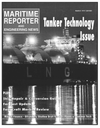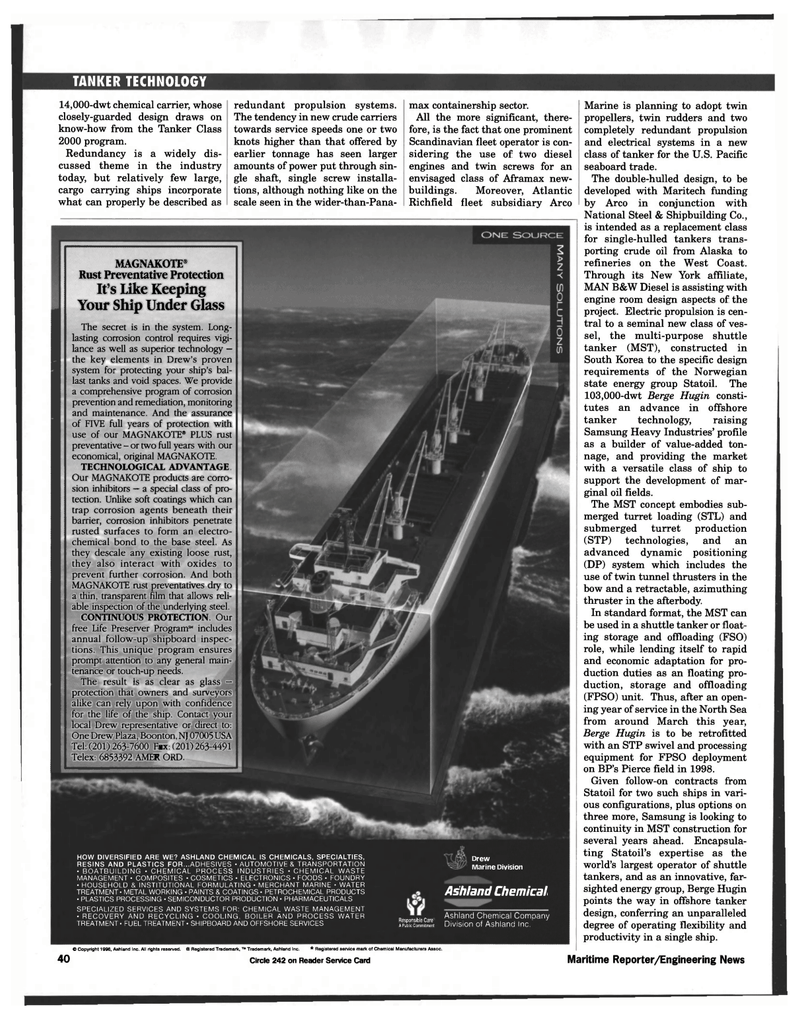
Page 32: of Maritime Reporter Magazine (March 1997)
Read this page in Pdf, Flash or Html5 edition of March 1997 Maritime Reporter Magazine
TANKER TECHNOLOGY 14,000-dwt chemical carrier, whose closely-guarded design draws on know-how from the Tanker Class 2000 program.
Redundancy is a widely dis- cussed theme in the industry today, but relatively few large, cargo carrying ships incorporate what can properly be described as redundant propulsion systems.
The tendency in new crude carriers towards service speeds one or two knots higher than that offered by earlier tonnage has seen larger amounts of power put through sin- gle shaft, single screw installa- tions, although nothing like on the scale seen in the wider-than-Pana- max containership sector.
All the more significant, there- fore, is the fact that one prominent
Scandinavian fleet operator is con- sidering the use of two diesel engines and twin screws for an envisaged class of Aframax new- buildings. Moreover, Atlantic
Richfield fleet subsidiary Arco
MAGNAKOTE® Rust Preventative Protection
It's Like Keeping
Your Ship Under Glass
The secret is in the system. Long- lasting corrosion control requires vigi- lance as well as superior technology — the key elements in Drew's proven system for protecting your ship's bal- last tanks and void spaces. We provide a comprehensive program of corrosion prevention and remediation, monitoring and maintenance. And the assurance of FIVE full years of protection with use of our MAGNAKOTE® PLUS rust preventative - or two full years with our economical, original MAGNAKOTE.
TECHNOLOGICAL ADVANTAGE
Our MAGNAKOTE products are corro- sion inhibitors — a special class of pro- tection. Unlike soft coatings which can trap corrosion agents beneath their barrier, corrosion inhibitors penetrate rusted surfaces to form an electro- chemical bond to the base steel. As they descale any existing loose rust, they also interact with oxides to prevent further corrosion. And both
MAGNAKOTE rust preventatives dry to a thin, transparent film that allows reli- able inspection of the underlying steel.
CONTINUOUS PROTECTION. Our free Life Preserver Program™ includes annual follow-up shipboard inspec- tions. This unique program ensures prompt attention to any general main- tenance or touch-up needs.
The result is as clear as glass — protection that owners and surveyors alike can rely upon with confidence for the life of the ship. Contact your local Drew representative or direct to:
One Drew Plaza, Boonton, NJ 07005 USA
Tel: (201) 263-7600 Fax: (201) 263-4491
Telex: 6853392 AMER ORD.
HOW DIVERSIFIED ARE WE? ASHLAND CHEMICAL IS CHEMICALS, SPECIALTIES,
RESINS AND PLASTICS FOR...ADHESIVES • AUTOMOTIVE & TRANSPORTATION • BOATBUILDING • CHEMICAL PROCESS INDUSTRIES • CHEMICAL WASTE
MANAGEMENT • COMPOSITES • COSMETICS • ELECTRONICS • FOODS • FOUNDRY • HOUSEHOLD & INSTITUTIONAL FORMULATING • MERCHANT MARINE • WATER
TREATMENT- METAL WORKING • PAINTS & COATINGS • PETROCHEMICAL PRODUCTS • PLASTICS PROCESSING • SEMICONDUCTOR PRODUCTION • PHARMACEUTICALS
SPECIALIZED SERVICES AND SYSTEMS FOR: CHEMICAL WASTE MANAGEMENT • RECOVERY AND RECYCLING • COOLING, BOILER AND PROCESS WATER
TREATMENT- FUEL TREATMENT- SHIPBOARD AND OFFSHORE SERVICES Responsible Care A Public Commitment
Drew
Marine Division
Ashland Chemical
Ashland Chemical Company
Division of Ashland Inc. © Copyright 1996, Ashland Inc. All rights reserved. ® Registered Trademark, ™ Trademark, Ashland Inc. * Registered service mark of Chemical Manufacturers Assoc. 40 Circle 242 on Reader Service Card
Marine is planning to adopt twin propellers, twin rudders and two completely redundant propulsion and electrical systems in a new class of tanker for the U.S. Pacific seaboard trade.
The double-hulled design, to be developed with Maritech funding by Arco in conjunction with
National Steel & Shipbuilding Co., is intended as a replacement class for single-hulled tankers trans- porting crude oil from Alaska to refineries on the West Coast.
Through its New York affiliate,
MAN B&W Diesel is assisting with engine room design aspects of the project. Electric propulsion is cen- tral to a seminal new class of ves- sel, the multi-purpose shuttle tanker (MST), constructed in
South Korea to the specific design requirements of the Norwegian state energy group Statoil. The 103,000-dwt Berge Hugin consti- tutes an advance in offshore tanker technology, raising
Samsung Heavy Industries' profile as a builder of value-added ton- nage, and providing the market with a versatile class of ship to support the development of mar- ginal oil fields.
The MST concept embodies sub- merged turret loading (STL) and submerged turret production (STP) technologies, and an advanced dynamic positioning (DP) system which includes the use of twin tunnel thrusters in the bow and a retractable, azimuthing thruster in the afterbody.
In standard format, the MST can be used in a shuttle tanker or float- ing storage and offloading (FSO) role, while lending itself to rapid and economic adaptation for pro- duction duties as an floating pro- duction, storage and offloading (FPSO) unit. Thus, after an open- ing year of service in the North Sea from around March this year,
Berge Hugin is to be retrofitted with an STP swivel and processing equipment for FPSO deployment on BP's Pierce field in 1998.
Given follow-on contracts from
Statoil for two such ships in vari- ous configurations, plus options on three more, Samsung is looking to continuity in MST construction for several years ahead. Encapsula- ting Statoil's expertise as the world's largest operator of shuttle tankers, and as an innovative, far- sighted energy group, Berge Hugin points the way in offshore tanker design, conferring an unparalleled degree of operating flexibility and productivity in a single ship.
Maritime Reporter/Engineering News

 31
31

 33
33
